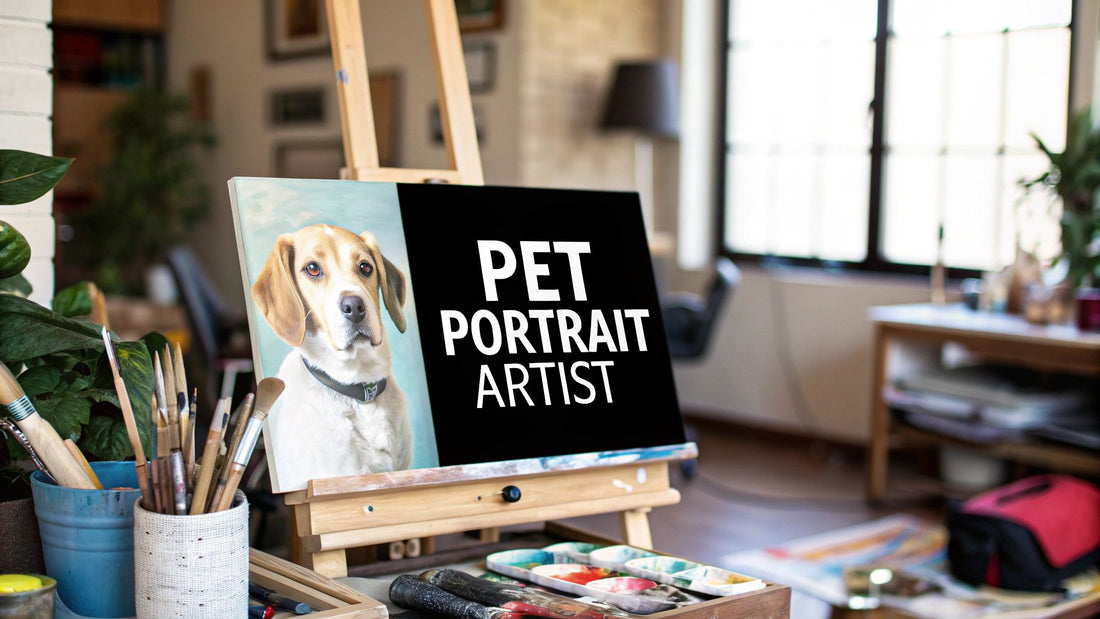A custom pet portrait artist does more than just paint a picture of your pet—they turn a beloved photo into a one-of-a-kind piece of art that you'll cherish forever. The key is finding an artist whose style clicks with your vision and who can truly capture your pet's unique personality.
Defining Your Vision for the Perfect Portrait
Before you even start scrolling through artist portfolios, the real first step begins with you. Take a moment and really think about what you want this portrait to feel like.
Are you dreaming of a classic, hyper-realistic oil painting that would look right at home in a formal living room? Or maybe something more modern, like a bright and whimsical digital illustration that perfectly captures your dog's goofy side?
Figuring this out first is a game-changer. It immediately narrows down your search from an overwhelming number of choices to a much more manageable list. Knowing you want a modern, abstract vibe versus a traditional, highly-detailed portrait helps you zero in on the right artists from the get-go.
Popular Artistic Styles to Consider
Not sure where to start? Here are a few popular styles you'll come across as you search for a custom pet portrait artist:
- Realism/Hyper-realism: This is all about creating a lifelike, almost photographic-quality portrait. The artist focuses on capturing every single detail, from the texture of the fur to that little glint in their eyes.
- Impressionism: With its visible brushstrokes and focus on light, this style is less about perfect detail and more about capturing a feeling or a fleeting moment. It’s a beautiful way to show off a pet's vibrant energy.
- Whimsical/Cartoon: This style is pure fun. It often involves exaggerated features and bold, playful colors to create a charming portrait that highlights all of your pet’s adorable quirks.
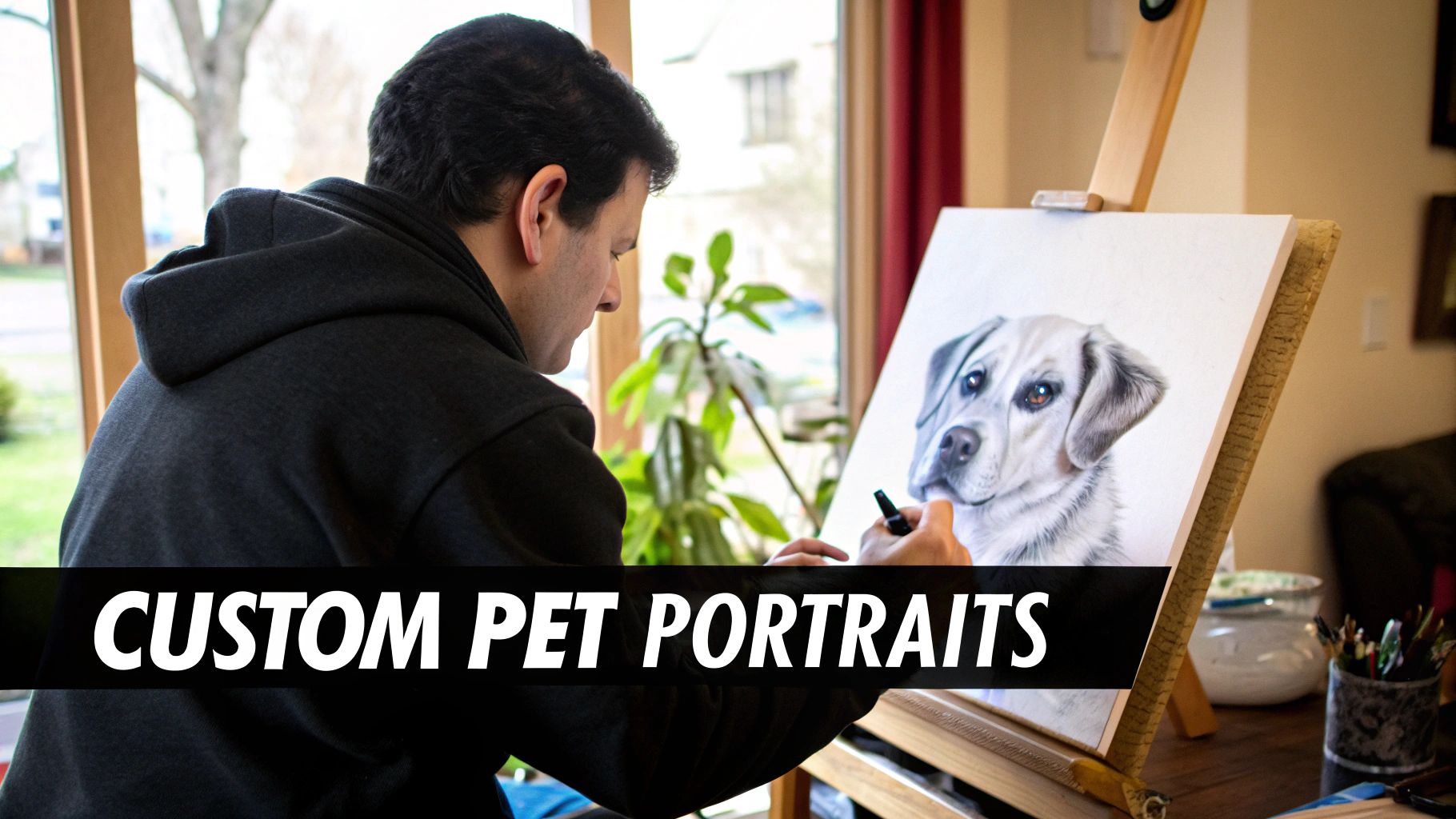
The style you choose really sets the tone for the entire piece. Think about where it will hang and, more importantly, your pet's personality. A stoic Great Dane might be the perfect subject for a classic oil painting, while a mischievous kitten would shine in a colorful, whimsical illustration.
The desire for these personalized keepsakes is booming. Just look at the pet photography market—it was valued at USD 1.1 billion and is expected to hit USD 2.4 billion by 2035. This huge growth shows just how much we adore our furry family members and want to celebrate them.
If you're looking for more guidance, our detailed article offers some great tips on finding the perfect pet portrait artist.
How to Review an Artist's Portfolio
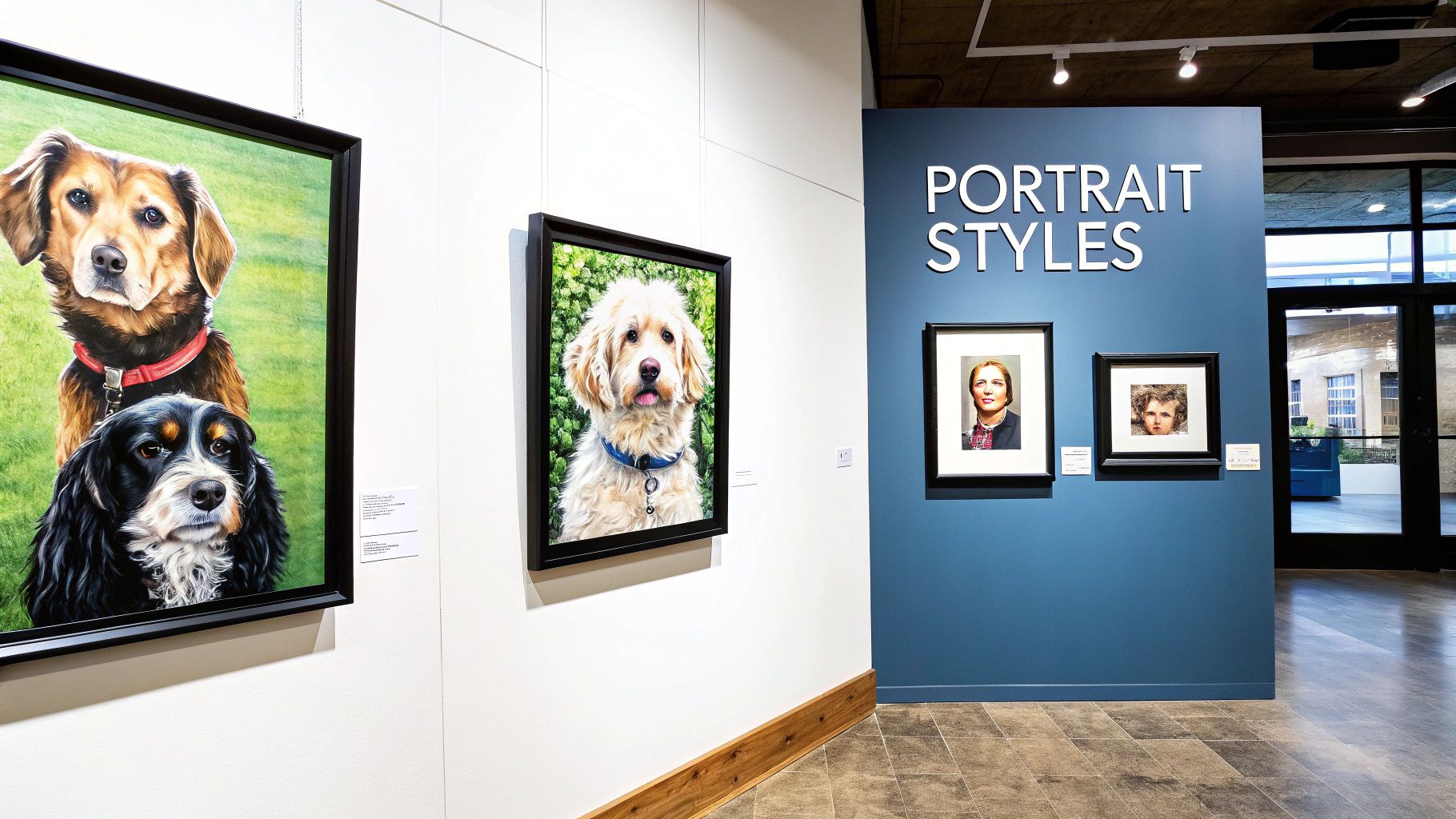
So, you’ve got a shortlist of artists. Fantastic! Now comes the fun part: diving into their portfolios. Think of this as more than just window shopping. A portfolio is an artist’s visual resume, and it tells you everything you need to know about their skill, style, and—most importantly—their ability to capture an animal’s spirit.
As you browse, keep an eye out for consistency. You want to see a high level of quality across the board, not just one or two showstoppers surrounded by mediocre pieces. A great artist delivers excellence with every commission.
This is also where you get a real feel for their artistic voice. Pay attention to how they play with color, light, and composition. Does the art feel vibrant and energetic, or does it have a more calm, peaceful vibe? You're looking for a style that resonates with you.
Looking Beyond the Brushstrokes
It's easy to get wowed by a pretty picture, but now’s the time to put on your critic’s hat and look closer at the technical details. An artist's true talent often hides in the small things.
Can they paint different fur textures convincingly? Think about the wispy softness of a long-haired cat versus the short, dense coat of a boxer. What about those tricky features, like a wet nose that actually looks wet or whiskers that seem to pop off the canvas?
The real test? The eyes. I always say the eyes are where an animal’s soul lives, and a truly gifted artist knows exactly how to capture that light. If the eyes in their past work feel flat or vacant, that's a red flag. It might mean they'll struggle to capture your pet's unique personality.
A great portfolio should do more than just impress you; it should make you feel something. The best artists don’t just paint what a pet looks like. They capture who that pet is. When you find yourself smiling at the painted mischief of a terrier or feeling the quiet dignity of a senior cat, you know you’ve struck gold.
Find Your Pet's "Doppelgänger"
Here’s a little trick I’ve picked up over the years: actively search the portfolio for pets that look like yours. This is the best way to gut-check an artist's ability to handle your pet’s specific features.
- Fluffy vs. Sleek: If you have a long-haired beauty like a Samoyed, see how the artist handles all that white fur. Do they create texture and depth, or does it look like a white blob?
- The Black Pet Challenge: Painting black cats and dogs is notoriously difficult. Look for examples to see if the artist can create highlights and definition so your pet doesn't get lost in the shadows.
- Breed-Specific Quirks: The charming wrinkles of a Pug require a completely different approach than the elegant lines of a Greyhound. See if they’ve successfully painted pets with similar features to your own.
Finding a beautiful portrait of an animal who could be your pet’s twin is the ultimate confidence booster. It tells you the artist has the exact skills needed to do your furry (or feathered, or scaled!) friend justice.
Working with Your Artist: A Step-by-Step Guide
So, you’ve found the one—the artist whose work makes your heart sing. Now what? Commissioning a piece of art can feel a little mysterious if you've never done it, but it’s really just a friendly, creative conversation.
When you first reach out, think of it as starting a collaboration. You're not just buying a product; you're co-creating something special. Kick things off by telling them what you love about their style and what you're dreaming of for your own portrait.
A few key details will help them give you an accurate quote right away:
- Size: Have a spot in mind? Let them know. "I'm thinking of something for over the fireplace, maybe around 16x20 inches," is super helpful.
- Medium: If their gallery has a mix, tell them your preference. "I absolutely love the look of your oil paintings."
- Deadline: If it’s a surprise for a birthday or anniversary, mention the date upfront!
Don't worry, this first email isn't a binding contract. It's just an opener. The artist will get back to you with their availability, a rough timeline, and how their pricing works.
From First Sketch to Final Masterpiece
Once you give the green light, the real magic begins. You'll likely be asked for a deposit (usually 50%) to secure your spot and, of course, the best photos of your furry (or feathery) friend.
From there, most artists follow a pretty standard process to make sure you're part of the journey and love the final result.
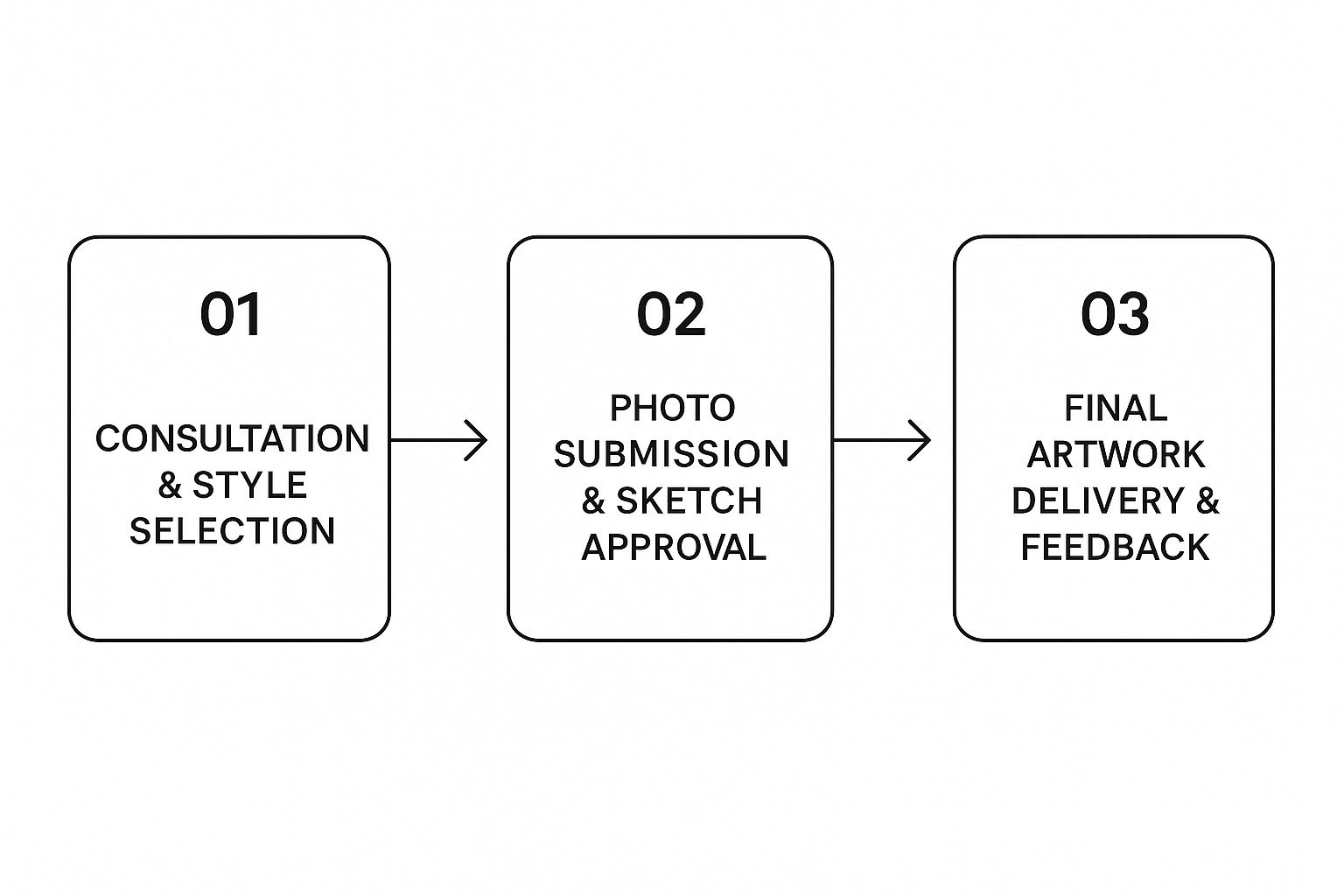
As you can see, you're a key player in this process, and your most important moment to shine is right at the beginning: the sketch approval.
This is your golden opportunity to give feedback. Does the composition feel right? Did they capture that quirky way his ear flops? Speaking up now is easy for the artist to adjust. Waiting until the painting is nearly done can mean major, time-consuming changes.
Don’t be shy about offering specific, thoughtful feedback. Your artist wants you to be thrilled! A comment like, “You nailed the look in his eyes! Could we just make his smile a little goofier?” is the kind of actionable guidance that helps them create the perfect portrait for you.
So, what's behind the price tag on that gorgeous custom portrait you've been eyeing? It's more than just paint and canvas. Think of it as an investment in a one-of-a-kind memory, and knowing what you're paying for makes the whole process smoother.
The final cost isn't just a number an artist pulls out of thin air. It’s a thoughtful blend of a few key things.
Breaking Down the Cost
The most obvious factor is the size. A larger canvas simply requires more materials and, more importantly, a lot more time to fill. The medium you choose is another huge piece of the puzzle. An intricate oil painting, with its multiple layers and long drying times, is a much bigger undertaking than a quick charcoal sketch or a digital piece.
Then there's the complexity of the portrait itself. A simple head-and-shoulders shot of your furry friend against a solid background is going to be less of a time commitment for the artist than, say, a full-body portrait of them lounging in their favorite armchair. Want to add a second pet or capture the detailed pattern on their special collar? These additions will naturally factor into the final price.
It's All About the Artist's Expertise
Perhaps the biggest driver of cost is the artist's experience and reputation. You'll see a massive price range out there, and this is why. A seasoned custom pet portrait artist with a portfolio that could hang in a gallery and a long waiting list will deservedly charge more than someone just starting out.
You're not just buying a painting. You're investing in the thousands of hours that artist poured into their craft to learn how to capture the unique glint in your pet's eye.
That’s why you might find a lovely portrait for under $100 from an up-and-coming artist, while a world-renowned professional might charge thousands. It’s a spectrum, and your budget will help you find the right artist for you.
Remember, this is their business and their livelihood. After covering materials, studio space, and other expenses, most professional artists see a net profit of around 20% to 30%. If you're curious about the financial side of being an artist, you can learn more about artist earnings and business finances.
Finally, don't be surprised when an artist asks for a deposit. It's standard practice to require 50% upfront to secure your spot and cover initial material costs. The rest is typically due once your beautiful portrait is finished.
Taking the Perfect Reference Photos for Your Artist
The secret to a breathtaking portrait? It almost always starts with a great photograph. You're the artist's eyes on the ground, and giving them clear, detailed photos is the single most important thing you can do to help them capture your pet’s true spirit.
Think about it this way: an artist can only paint what they can see. A fuzzy, poorly lit photo forces them to guess at the details, while a sharp, vibrant image gives them a perfect roadmap. When an artist can zoom right in and see the tiny color flecks in your dog’s eyes or the specific direction their fur grows, that’s where the magic happens. Those are the details that make a portrait feel alive.
Lighting and Angles Are Everything
Natural light is your absolute best friend here. If you can, take your pet outside on a bright but overcast day or position them near a large window. This kind of soft, diffused light is fantastic because it avoids the harsh shadows that hide features and throw off colors. It gives the artist a true-to-life palette to work from.
Next, get down on their level. It’s a simple trick, but it's a game-changer. Photos taken from above always make a pet look a little small and distorted. Crouching down to their eye level creates a much more personal and engaging portrait—one that really captures their world.
Pro Tip: A crystal-clear shot of the eyes is the holy grail. The eyes are where all the personality and soul come through. Make sure they're in sharp focus, wide open, and don't have any weird glare or red-eye from a flash.
A Quick Guide to Great (and Not-So-Great) Photos
To make it even easier, here’s a quick rundown of what makes your artist’s job a dream versus what gives them a headache.
Photos Your Artist Will Love You For:
- Clear & Focused: The subject is sharp, especially around the face and eyes.
- Good Lighting: Taken in bright, natural light that shows their true fur color. No harsh sun!
- Eye-Level Angle: Shot from your pet's perspective for a natural, flattering pose.
- High Resolution: The original, large file straight from your phone or camera.
Photos to Skip Sending:
- Blurry or Far Away: If you can't see the details, neither can the artist.
- Harsh Shadows or Flash: This creates unnatural colors and completely hides important features.
- Weird Angles: Photos looking straight down on your pet can really distort their proportions.
- Screenshots: Please, no screenshots! They crush the image quality and are far too pixelated to be useful.
Caring for Your New Family Heirloom
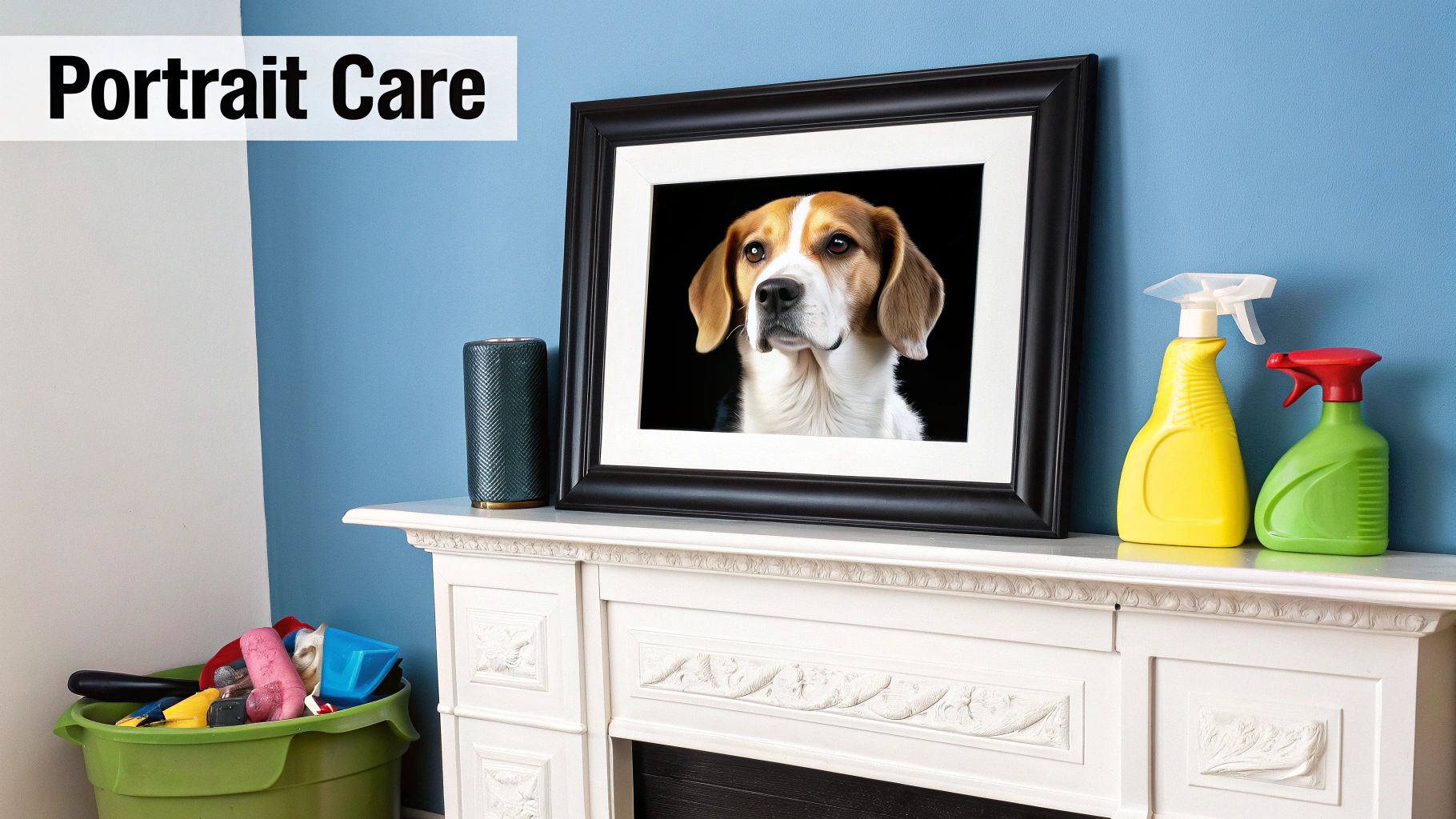
The moment your custom pet portrait arrives is pure excitement. After all the anticipation, this beautiful piece of art is finally in your hands. But remember, this isn't just another delivery—it's a future family heirloom that captures a special bond, so it deserves a little extra care right from the start.
When you're ready to unbox it, find a clean, flat surface to work on. It's best to handle the artwork by its edges, as the natural oils on your fingertips can leave smudges or even damage the delicate surface of the paint over time. Let it sit and acclimate to your home's temperature and humidity for a bit before hanging it.
This kind of art holds incredible sentimental value, which is why it's become so popular. In fact, when you look at customer feedback for pet portraits, the word 'amazing' shows up in 22% of reviews and 'beautiful' in another 17%. That speaks volumes about how much these pieces mean to people. You can see more about the growing trends in custom pet art on Accio.com.
Keeping Your Portrait Perfect for Years to Come
You don't need to be a museum curator to protect your investment. A few simple precautions will keep your portrait looking as stunning as the day you got it. The two biggest culprits to watch out for are sunlight and moisture.
- Mind the Sun: Direct sunlight is the enemy of vibrant color. Those powerful UV rays can cause pigments to fade over the years. Find a spot for your portrait on a wall that isn't blasted by intense, direct sun.
- Avoid Humidity: Think twice before hanging your artwork in a bathroom or right over the stove in the kitchen. Fluctuating humidity can cause the canvas to sag or the frame to warp.
A good frame isn't just for looks—it's a shield. For ultimate protection, think about investing in a frame with UV-protective glass. It’s an extra layer of defense that keeps the colors true and bright for a lifetime.
With just a little attention, your portrait will become a lasting tribute to your furry friend. If you want to dive deeper into why these paintings resonate so deeply, check out our article on the healing power of pet portraits.
Got Questions About Pet Portrait Commissions? Let's Clear Them Up
It's totally normal to have a few questions before you dive into commissioning a custom portrait. In fact, it's smart! Here are some of the most common things people wonder about, along with some straightforward answers from my experience.
How Long Does a Custom Pet Portrait Usually Take?
You'll find that the timeline can swing pretty widely, usually somewhere between two weeks and three months. A few key things will affect how long it takes to get your finished piece.
The artist's waitlist is often the biggest factor—popular artists can be booked up for months. The size and complexity of the painting also make a big difference, as does the medium itself. Oil paints, for instance, need a lot of drying time between layers, which naturally extends the process. Always, always ask for a timeline estimate before you put down a deposit.
What if I Don't Have a Good Photo of My Pet?
This is a really common concern, especially if your beloved pet is no longer with you. But don't despair if you don't have that one perfect high-resolution shot. Many artists are absolute wizards at working from several less-than-perfect photos.
The trick is to be open about it from the start. A skilled artist can often pull together the best features from different images—maybe the exact color of their fur from one photo and that goofy, head-tilting expression you loved from another. They can piece together the puzzle to truly capture your pet's spirit.
Clear communication about your photos is everything. A good artist will tell you honestly what they can work with and guide you through the process of bringing your pet's memory to life, even from imperfect pictures.
Can I Ask for Changes During the Process?
This one comes down to each artist's specific policy, so you'll need to ask. Most professionals will include one or two rounds of small adjustments, typically after you approve the initial sketch or in the early painting stages. This is your moment to speak up!
Requesting a major change when the painting is nearly done is a different story. With traditional media like oils or watercolors, big edits can be difficult or even impossible without starting over, which might mean extra fees. Your best bet is to get clarity on the revision policy before the first brushstroke hits the canvas. It just makes for a much smoother and happier experience for everyone.
Ready to turn your favorite photo into a timeless work of art? At William Tucker Art, we specialize in creating stunning, lifelike portraits that capture your pet’s unique spirit. Commission your portrait today
